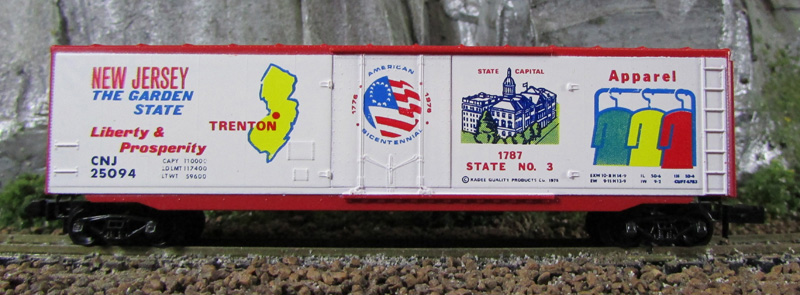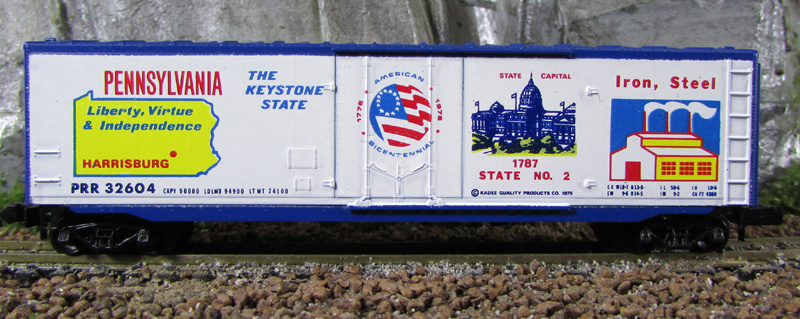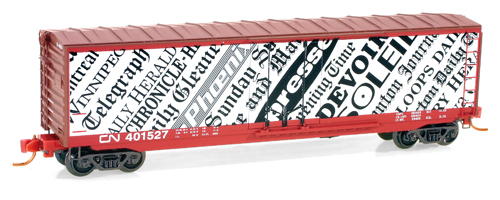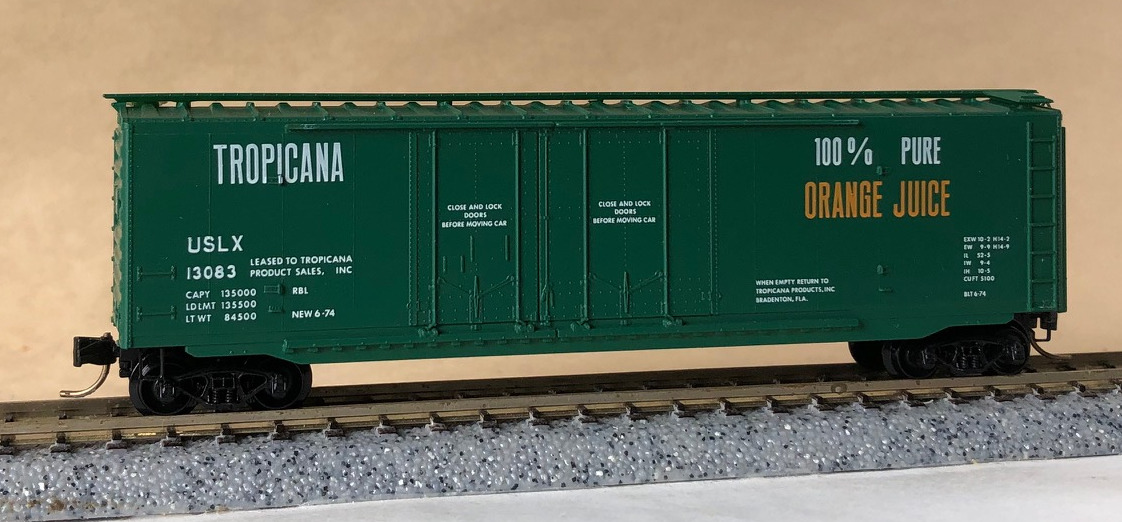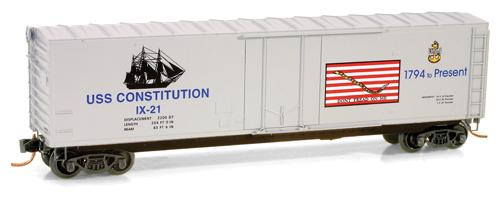Micro-Trains - 38050 - Boxcar, 50 Foot, Steel, Plug Door - Jersey Central - 25094
| Stock Number | 38050 |
| Secondary Stock Number | 038 00 050 |
| Tertiary Stock Number | 28051 |
| Original Retail Price | $4.50 |
| Brand | Micro-Trains |
| Manufacturer | Kadee Quality Products |
| Body Style | Micro-Trains 038 Boxcar 50 Foot Steel Plug Door No Roofwalk |
| Image Provider's Website | Link |
| Prototype Vehicle | Boxcar, 50 Foot, Steel, Plug Door (Details) |
| Road or Company Name | Jersey Central (Details) |
| Reporting Marks | CNJ |
| Road or Reporting Number | 25094 |
| Paint Color(s) | red, white sides |
| Additional Markings/Slogan | New Jersey |
| Coupler Type | MT Magne-Matic Knuckle |
| Coupler Mount | Truck-Mount |
| Wheel Type | Plastic Wheels With Steel Axle |
| Wheel Profile | Standard |
| Series Name | MTL Bicentennial |
| Release Date | 1975-11-01 |
| Item Category | Rolling Stock (Freight) |
| Model Type | Boxcar |
| Model Subtype | 50 Foot |
| Model Variety | Steel Plug Door No Roofwalk |
| Prototype Region | North America |
| Prototype Era | NA Era IV: 2nd Gen Diesel (1958 - 1978) |
| Scale | 1/160 |
Specific Item Information:
Rapido coupler version is 38051.
Prototype History:
The 50-foot boxcar made its first appearance in the 1930s and steadily grew in popularity over the years, which further improved redundancies by allowing for even more space within a given car. Today, the 50-footer remains the common boxcar size. After the second world war ended, and steel became once again readily available, steel became the go-to choice for construction of boxcars. Pullman Standard and ACF were some of the most prolific builders of these cars.
In the 1960s, the flush, "plug" style sliding door was introduced as an option that provides a larger door to ease loading and unloading of certain commodities. The tight-fitting doors are better insulated and allow a car's interior to be maintained at a more even temperature.
In the 1960s, the flush, "plug" style sliding door was introduced as an option that provides a larger door to ease loading and unloading of certain commodities. The tight-fitting doors are better insulated and allow a car's interior to be maintained at a more even temperature.
Road Name History:
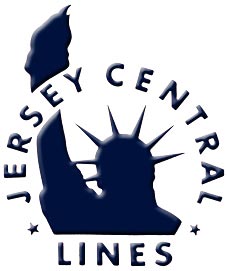 The Central Railroad of New Jersey, also known as the Jersey Central or Jersey Central Lines (reporting mark CNJ), was a Class I railroad with origins in the 1830s. It was absorbed into Conrail in April 1976 along with several other prominent bankrupt railroads of the northeastern United States.
The Central Railroad of New Jersey, also known as the Jersey Central or Jersey Central Lines (reporting mark CNJ), was a Class I railroad with origins in the 1830s. It was absorbed into Conrail in April 1976 along with several other prominent bankrupt railroads of the northeastern United States.
The Elizabethtown and Somerville Railroad was chartered on February 9, 1831, to build from Elizabeth on the Newark Bay (with a steamboat transfer to New York City) west to Somerville. The line to Plainfield was completed in March 1839, connecting to the New Jersey Rail Road in Elizabeth. Extensions took it west to Dunellen in 1840, just east of Bound Brook in 1841 and to Somerville in 1842.
The Somerville and Easton Railroad was chartered on February 26, 1847, to continue the line west to Easton, Pennsylvania. The first extension, to Whitehouse, opened in 1848 and was leased to the Elizabethtown and Somerville Railroad. On February 11, 1849, the Elizabethtown and Somerville Railroad bought the Somerville and Easton Railroad, and on February 26 the two companies were consolidated as the Central Railroad of New Jersey.

The Elizabethtown and Somerville Railroad was chartered on February 9, 1831, to build from Elizabeth on the Newark Bay (with a steamboat transfer to New York City) west to Somerville. The line to Plainfield was completed in March 1839, connecting to the New Jersey Rail Road in Elizabeth. Extensions took it west to Dunellen in 1840, just east of Bound Brook in 1841 and to Somerville in 1842.
The Somerville and Easton Railroad was chartered on February 26, 1847, to continue the line west to Easton, Pennsylvania. The first extension, to Whitehouse, opened in 1848 and was leased to the Elizabethtown and Somerville Railroad. On February 11, 1849, the Elizabethtown and Somerville Railroad bought the Somerville and Easton Railroad, and on February 26 the two companies were consolidated as the Central Railroad of New Jersey.
Brand/Importer Information:
Micro-Trains is the brand name used by both Kadee Quality Products and Micro-Trains Line. For a history of the relationship between the brand and the two companies, please consult our Micro-Trains Collector's Guide.
Manufacturer Information:
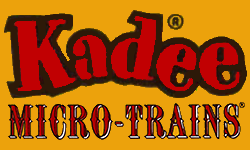 Kadee Quality Products originally got involved in N-Scale by producing a scaled-down version of their successful HO Magne-Matic knuckle coupler system. This coupler was superior to the ubiquitous 'Rapido' style coupler due to two primary factors: superior realistic appearance and the ability to automatically uncouple when stopped over a magnet embedded in a section of track. The success of these couplers in N-Scale quickly translated to the production of trucks, wheels and in 1972 a release of ready-to-run box cars.
Kadee Quality Products originally got involved in N-Scale by producing a scaled-down version of their successful HO Magne-Matic knuckle coupler system. This coupler was superior to the ubiquitous 'Rapido' style coupler due to two primary factors: superior realistic appearance and the ability to automatically uncouple when stopped over a magnet embedded in a section of track. The success of these couplers in N-Scale quickly translated to the production of trucks, wheels and in 1972 a release of ready-to-run box cars.
In October 1990 Kadee separated in two companies, with the newly created Micro-Trains® Line Co. continuing the Z, Nn3, and N Scale product ranges, with Kadee retaining the HO range.

In October 1990 Kadee separated in two companies, with the newly created Micro-Trains® Line Co. continuing the Z, Nn3, and N Scale product ranges, with Kadee retaining the HO range.
Item created by: Lethe
on 2015-05-31 17:46:30
Last edited by: gdm on 2020-07-24 07:29:25
If you see errors or missing data in this entry, please feel free to log in and edit it. Anyone with a Gmail account can log in instantly.
Last edited by: gdm on 2020-07-24 07:29:25
If you see errors or missing data in this entry, please feel free to log in and edit it. Anyone with a Gmail account can log in instantly.


